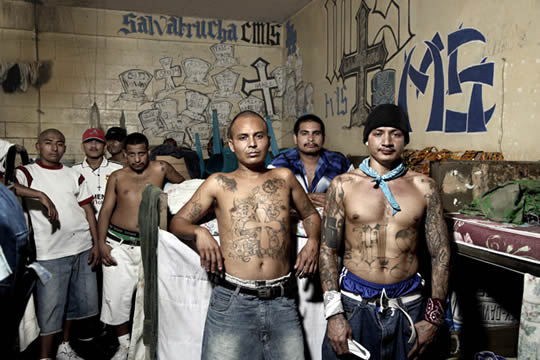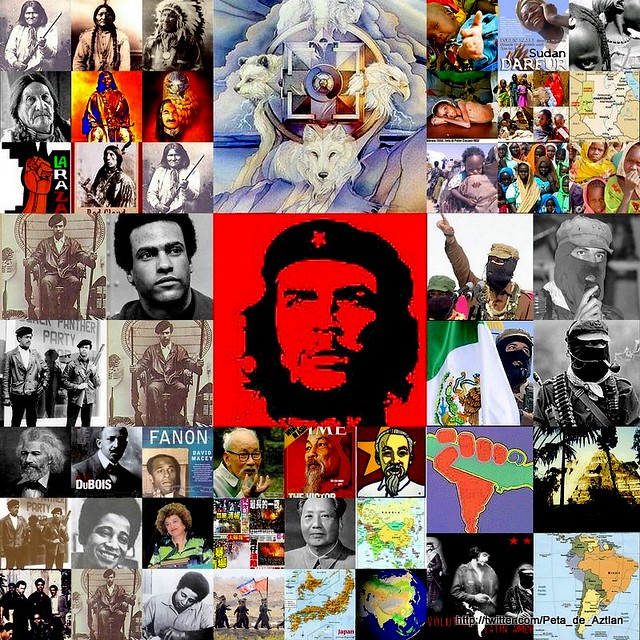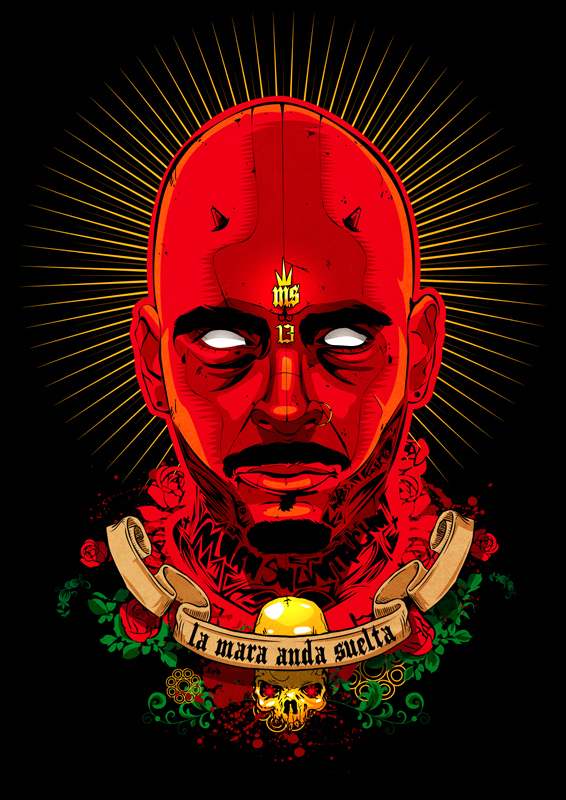+++++++++++++++++++++++++
Venceremos! We Will Win! Educate to Liberate!
Peter S. Lopez AKA @Peta_de_Aztlan
Sacramento, California
c/s
Venceremos! We Will Win! Educate to Liberate!
Peter S. Lopez AKA @Peta_de_Aztlan
Sacramento, California
c/s
----- Forwarded Message -----
From: Blogger <no-reply@blogger.com>
To: peter.lopez51@yahoo.com
Sent: Thursday, December 20, 2012 8:23 AM
Subject: [HELP-Matrix Blog] On Mara Salvatrucha AKA MS-13 ~VIA @InSightCrime
http://www.insightcrime.org/groups-el-salvador/mara-salvatrucha-ms-13
++++

++++
Mara Salvatrucha AKA MS-13
- Written byInSight Crime
Read more about:++++
The Mara Salvatrucha, or MS-13, is perhaps the most notorious street gang in the Western Hemisphere. While it has its origins in the poor, refugee-laden neighborhoods of 1980s Los Angeles, the gang's reach now extends from Central American nations like El Salvador and through Mexico, the United States, and Canada. They rob, extort and bully their way into neighborhoods and have gradually turned to transnational crimes such as human smuggling and drug trafficking. Their activities have helped make the Northern Triangle -- Guatemala, El Salvador, and Honduras -- the most violent place in the world that is not at war. In October 2012, the US Department of the Treasury labeled the group a "transnational criminal organization," the first such designation for a US street gang.Origins
The MS-13 was founded in the "barrios" of Los Angeles in the 1980s. As a result of the civil wars wracking El Salvador, Guatemala, and Nicaragua, refugees flooded northward. Many of them wound up in Los Angeles, living among the mostly Mexican barrios of East Los Angeles. While the Mexican gangs reined in the local underworld, the war-hardened immigrants quickly organized themselves into competing groups, the strongest of which was called the Mara Salvatrucha.
The gang was initially composed of refugees from El Salvador in the Pico Union neighborhood, which is where the name comes from: "mara" is a Central American term for gang; "salva" refers to El Salvador; "trucha," which means "trout" in English, is a slang term for "clever" or "sharp." However, with the concentration of Spanish speakers in Los Angeles, the gang expanded into other nationalities and then into other cities.
The gang's rivals took note. One, known as the Mexican Mafia, or "la M" for short, one of the most storied of California's gangs, decided to integrate the MS into their regional latino gang alliance. Called the "Sureños," the alliance included many prominent gangs and stretched into much of the southwest of the United States and Mexico. It afforded the MS more protection in the barrios and in prison. In return, the MS provided hitmen and added the number 13, the position M occupies in the alphabet, to their name. Thus, the MS became the MS-13.
By the end of the 1990s, the United States tried to tackle what they were starting to recognize was a significant criminal threat. Partly as a way to deal with MS-13, and partly as a product of the get-tough immigration push toward the end of the Clinton presidency, the government began a program of deportation of foreign-born residents convicted of a wide range of crimes. This enhanced deportation policy, in turn, vastly increased the number of gang members being sent home to El Salvador, Honduras, Guatemala, and elsewhere. According to one estimate, 20,000 criminals returned to Central American between 2000 and 2004. That trend continues. One U.S. law enforcement official told InSight that the U.S. sends 100 ex-convicts back per week just to El Salvador.
Central American governments, some of the poorest and most ineffective in the Western Hemisphere, were not capable of dealing with the criminal influx, nor were they properly forewarned by American authorities. The convicts, who often had only the scarcest connection to their countries of birth, had little chance of integrating into the legitimate society. They often turned to what they knew best: gang life.
In this way the decision to use immigration policy as an anti-gang tool spawned the virulent growth of the gang in the Northern Triangle: El Salvador, Guatemala, and Honduras. Numbers vary but the U.S. Southern Command says there are as many as 70,000 gang members in the Northern Triangle. The proliferation of gangs has accompanied a spike in murder rates. The area has the highest homicide rate in the world of a region not at war.
Of these gangs, the MS-13 is the largest in the region. Central American immigration to other portions of the U.S., such as New York City and the Washington D.C. area, helped foster the spread of MS-13 within the U.S. as well. MS-13's links to illegal human trafficking from Central America has helped solidify the gang's place in Mexico's crowded criminal landscape, especially in the southern border region.
Modus Operandi
On paper, the MS-13 has a hierarchy, a language, and a code of conduct. In reality, the gang is loosely organized, with cells across Central America, Mexico, and the United States, but without any single recognized leader. The leaders are known as "palabreros," loosely translated as "those who have the word." These leaders control what are known as "cliques," the cells that operate in specific territories.
These cliques have their own leaders and hierarchies. Most cliques have a "primera palabra" and "segunda palabra," in reference to first and second-in-command. Some cliques are transnational; some fight with others and have more violent reputations. Some cliques control smaller cliques in a given region. They also have treasurers and other small functionary positions.
MS-13's principal activities vary a great deal from one region to another. In Central America, where the gang's reach and size (relative to overall proportions) is largest, MS-13's operations are more diversified. This includes extortion, kidnapping and controlling the neighborhood illegal drug market. Their crimes, such as extorting the bus companies, are arguably more disruptive on a daily basis to more people than any other criminal activity in the region. In the U.S., in contrast, the gang operates much more like another American street gang, with an emphasis on local drug sales and "protecting" urban turf.
The MS-13 also maintains its relationship with the "M." The MS-13 have designated certain middle-men to pass tribute to the gang in Los Angeles. Some ascertain that the two organizations have formed an international triangle of power of sorts that runs from the Los Angeles area to El Salvador and back through the Washington D.C. - Virginia corridor.
With their historical roots in Central America and the cities of the United States, much of the recent growth of MS-13 has been concentrated in Mexico. The gang is strongest in the border region with Guatemala, especially the state of Chiapas. Drawn by the tens of thousands of Central American migrants seeking illicit passage through Mexico to the United States, MS-13 has developed into one of the foremost players in the nation's thriving human trafficking industry.
Thanks in large part to their shared territory, MS-13 have also begun to carve out relationships with some transnational drug trafficking networks. In Central America, MS-13 provides crucial manpower for the foreign organizations, helping gangs like the Zetas and the Sinaloa cartel sell drugs in the local market, intimidate rivals, and carry out executions. The group's role in human trafficking in southern Mexico has also allowed them to forge business relationships with some of the larger criminal groups, such as the Zetas, that have branched into that field.
To be sure, at its most potent, the MS-13 leadership can control the actions of these cliques from afar. This fluid, diffuse structure makes the gang resistant to any single government's attempt to crack down on it. Arrest the "primera palabra" and the "segunda" quickly assumes control. Throughout its existence, in fact, various governments' attempts to reduce the threat posed by MS-13 has instead often had the perverse impact of spreading the threat posed by the gang.
Perhaps the most obvious example is the aforementioned policy of deportations of foreign nationals committed of crimes in the U.S. But Central American governments have also contributed: the "mano dura," or "iron fist" policies, which jailed youths based on appearance and association as well criminal activities, became the norm following their implementation by Salvadoran President Antonio Saca in the early 2000s. As a result, El Salvador, Honduras, and Guatemala saw their prison populations overflow with members of MS-13 and other gangs.
Because the brittle prison systems in each of those nations was unprepared for the sudden influx of thousands of violent and organized gang members, violence rose sharply inside jails. In response, authorities separated the gangs, but this opened up space for them to reorganize. In prison, for example, they are given a freedom and safety that is no longer possible on the outside. They frequently have access to cellular phones, computers, and television. As a result, MS-13's Central American branches have been able to rebuild their organizational structures from the inside of the prisons walls, as well as expand their capacity to carry out crimes such as kidnappings, car robberies, extortion schemes, and other criminal activities.
The gang is now in its second or third generation and the cycle appears difficult to break. Youth enter as they often see it as their only way through the rising violence around them. Entry is often equally violent, including a "13-second" beat-down that can often end in tragedy even before one's gang-banging career gets started. Older members seeking to break free find internal rules they might have created keeping many of them from separating. Some cliques, for example, penalize desertion by killing the person. Even if they can break free of their membership, their tattoos have often branded them for life.
In El Salvador, at least, in recent months MS-13 members have seen something of a reprieve from their usual violent lifestyle. In March 2012, MS-13 leaders and their Barrio 18 rivals agreed to a nationwide "truce" brokered through community groups and the Church and facilitated by the government. The apparent ceasefire has been followed by a tremendous drop in El Salvador's homicide rate that many hope will signal a major shift in citizen security in the country. However, some critics of the truce fear that it has dangerously heightened the profile of the street gangs, and provided them with the resources necessary to exert greater influence on government institutions. The long term impact of the truce, as well just how long it will last, remain to be seen.
Resources
- "Gangs in Central America," Congressional Research Service, 3 January 2011. (pdf)
- "The MS-13 and 18th Street Gangs: Emerging Transnational Gang Threats?" Congressional Research Service, 30 January 2008. (pdf)
- Victor Ronquillo and Jorge Fernandez Menendez, "De los Maras a los Zetas," (Mexico City, 2007).
- Samuel Logan, This is for the Mara Salvatrucha: Inside the MS-13, America's Most Violent Gang, (New York, 2009).
- Steven S. Dudley, Drug Trafficking Organizations in Central America: Transportistas, Mexican Cartels and Maras, Woodrow Wilson Center for International Scholars, May 2010.
- Ana Arana, How the Street Gangs Took Central America, Foreign Affairs, May/June 2005.
- Samuel Logan and John Sullivan, MS-13 Leadership: Networks of Influence, Security Solutions International, December 2010.
++++
++++

++++
++++
++++
++++++++++++++++++++++++++++++++++++++++
HELP-Matrix Humane-Liberation-Party Blog ~ http://help-matrix.blogspot.com/ ~
Humane-Liberation-Party Portal ~ http://help-matrix.ning.com/ ~
@Peta_de_Aztlan Blog ~ http://peta-de-aztlan.blogspot.com/ ~ @Peta_de_Aztlan
+++++++++++++++++++++++++++++++++++++++++

--
Posted By Blogger to HELP-Matrix Blog at 12/20/2012 08:23:00 AM




No comments:
Post a Comment